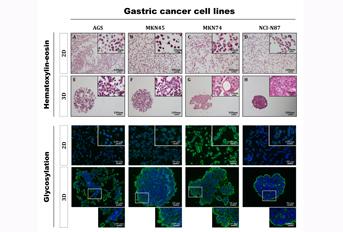Associação Portuguesa de Investigação em Cancro
Multicellular Human Gastric Cancer Spheroids Mimic the Glycosylation Phenotype of Gastric Carcinomas
Multicellular Human Gastric Cancer Spheroids Mimic the Glycosylation Phenotype of Gastric Carcinomas

3-dimensional (3D) systems mimic better the in vivo features of the tumor, however, the in vitro studies of cancer have been traditionally performed using 2D methods. In this study, published in the journal Molecules, a high-throughput 3D methodology has been established for four different gastric cancer cell lines. These cancer models have been fully characterised, focusing on the glycosylation profile, since it is known that changes in glycosylation are key players in cancer development and progression. The advances in 3D cell culture techniques could bridge the gap between 2D studies and in vivo animal models, providing researchers with more accurate in vitro models that would hasten cancer research and the development of more effective treatments.
This study was developed under a Marie Sklodowska-Curie grant (GlycoModels-748880), funded by the European Union’s Horizon 2020 research and innovation program.
Authors and Affiliations:
Meritxell Balmaña1,2, Stefan Mereiter1,2, Francisca Diniz1,2, Tália Feijão1,3, Cristina C. Barrias1,3,4 and Celso A. Reis1,2,4,5
1 i3S-Instituto de Investigação e Inovação em Saúde, Universidade do Porto, 4200-135 Porto, Portugal;
2 IPATIMUP-Institute of Molecular Pathology and Immunology, University of Porto, 4200-135 Porto, Portugal
3 INEB-Instituto de Engenharia Biomédica, University of Porto, 4200-135 Porto, Portugal
4 Institute of Biomedical Sciences of Abel Salazar–ICBAS, University of Porto, 4050-313 Porto, Portugal
5 Medical Faculty, University of Porto, 4200-319 Porto, Portugal
Abstract:
Cellular glycosylation plays a pivotal role in several molecular mechanisms controlling cell–cell recognition, communication, and adhesion. Thus, aberrant glycosylation has a major impact on the acquisition of malignant features in the tumor progression of patients. To mimic these in vivo features, an innovative high-throughput 3D spheroid culture methodology has been developed for gastric cancer cells. The assessment of cancer cell spheroids’ physical characteristics, such as size, morphology and solidity, as well as the impact of glycosylation inhibitors on spheroid formation was performed applying automated image analysis. A detailed evaluation of key glycans and glycoproteins displayed by the gastric cancer spheroids and their counterpart cells cultured under conventional 2D conditions was performed. Our results show that, by applying 3D cell culture approaches, the model cell lines represented the differentiation features observed in the original tumors and the cellular glycocalix underwent striking changes, displaying increased expression of cancer-associated glycan antigens and mucin MUC1, ultimately better simulating the glycosylation phenotype of the gastric tumor.
Journal: Molecules
Link: https://www.mdpi.com/1420-3049/23/11/2815




